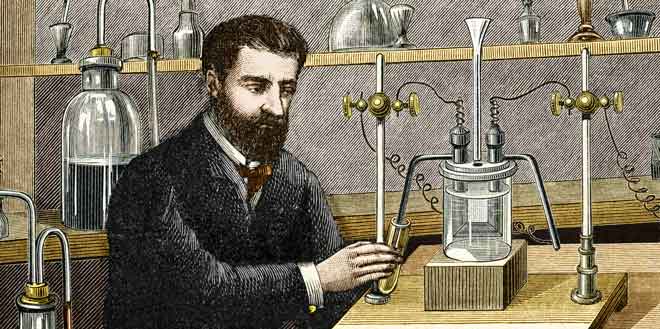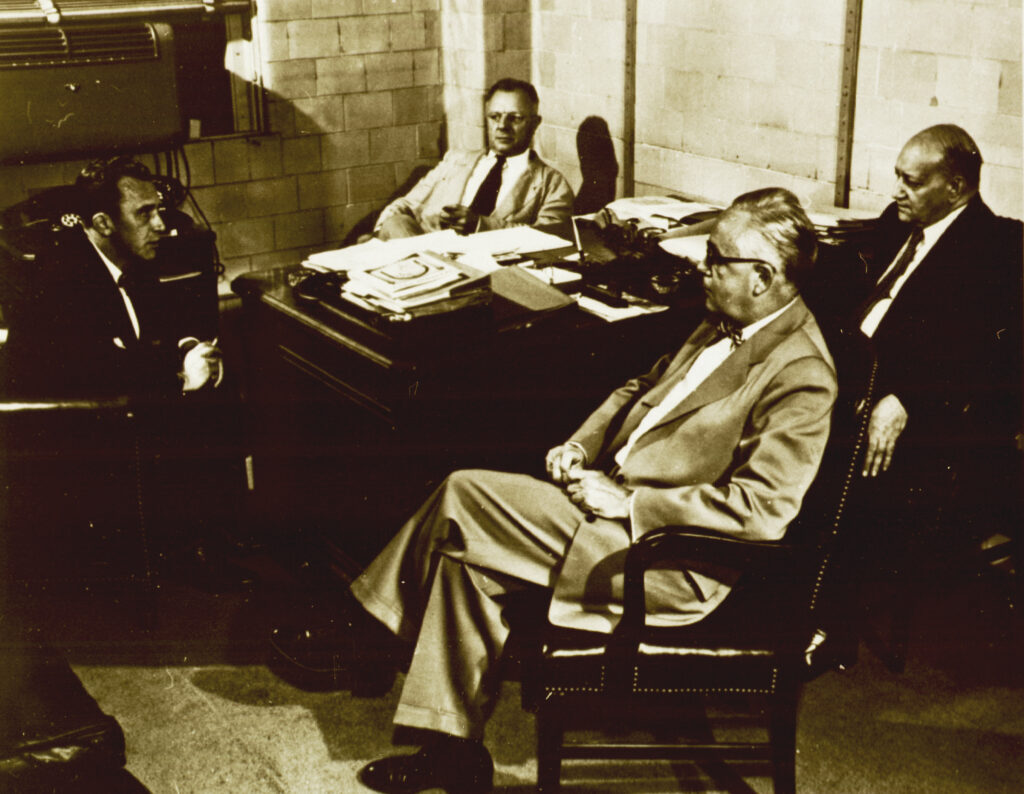The fluoridation era dawned sleepily enough in America. On the afternoon of January 25, 1945, municipal workers at the Grand Rapids, Michigan, waterworks began feeding powdered sodium fluoride into a system of basins, hoppers, filters, and tanks. The powder dissolved into the water supply and flowed out to the citizens of Grand Rapids. A great experiment had begun.
For nearly a year Grand Rapids had prepared for this moment. Children had lined school halls to “open wide” for preliminary examinations by the white-smocked workers from the U.S. Public Health Service. The city’s blue-collar residents had just helped deliver Michigan for Franklin D. Roosevelt by the slimmest of margins, and still remembered how FDR had pushed through the New Deal. Faith in the benevolence and efficacy of the federal government ran high. The Grand Rapids Herald boasted about the fluoride trial’s unique importance; the trial, nearly everyone believed, would prove fluoride’s cavity-fighting power. And the citizens of Grand Rapids would be a proud dental vanguard.
Still, not everyone shared this rosy view. Weeks before the start of fluoridation, city officials began receiving complaints about sore gums and peeling tooth enamel, after press accounts wrongly informed readers that the trial would begin in early January.
Such pockets of dissent—along with claims of provable harm—prefigured an impending battle, one now raging toward its seventh decade. The Grand Rapids trial continued as planned, with Public Health Service scientists observing a significant decrease in tooth decay among children sooner than they’d expected. The results were deemed so successful that the control city 40 miles away, Muskegon, Michigan, demanded fluoridation of its public water. Doing so brought the comparative study, intended to last fifteen years, to an end after only six. But by then communities across the country had begun fluoridating their water, with support from the Public Health Service, surgeon general, and American Dental Association. In 1951 five million Americans drank from fluoridated supplies; by 1960 that number grew to 41 million. As of 2008, the Centers for Disease Control and Prevention reported that 72% of the U.S. population had access to fluoridated water.
Despite this seemingly inexorable progression, a vocal opposition has persisted—perhaps most famously embodied in the grizzled and gruff cigar-chomping and gun-toting General Jack Ripper of Dr. Strangelove. In that 1964 film Ripper explains his rationale for inciting nuclear war: “Have you ever heard of a thing called fluoridation? Fluoridation of water? Do you realize that fluoridation is the most monstrously conceived and dangerous Communist plot we have ever had to face?”

Though General Ripper’s speech caricatured anti-Red paranoia, right-wing groups like the John Birch Society have long implied dark motives behind fluoridation. But more common are groups raising safety questions. Anti-fluoridation literature goes back over half a century, with titles like Robotry and Water: A Critique of Fluoridation (1959). Members of the Fluoride Action Network and Citizens for Safe Drinking Water have linked the chemical to several varieties of cancer, diminished intelligence, birth defects and declining birth rates, and heart disease—among other maladies. The Sierra Club worries about the “potential adverse impact of fluoridation on the environment, wildlife, and human health.”
Such sentiments are exceptions. The scientific and medical consensus, represented by the American Medical Association, National Academy of Sciences, and World Health Organization declares fluoridation a perfectly safe method of cavity prevention. The Centers for Disease Control and Prevention even named it one of the 10 great public-health achievements of the 20th century.
How did a seemingly benign chemical and a near-miraculous public-health initiative spark such heated debate? One more anti-fluoridation title offers a possible answer: The Case against Fluoride: How Hazardous Waste Ended Up in Our Drinking Water and the Bad Science and Powerful Politics That Keep It There. Many opponents see fluoridation as a consequence of collusion among industry, government, and a scientific establishment in thrall to both. The scientific evidence—more complicated than revealed during the original Grand Rapids trials—collides with skeptical public opinion. Seven decades of controversy remind us that the two realms are never truly separate.
Chasing the Colorado Stain
The path to widespread fluoridation began a century ago and a continent away. In 1901, in Naples, Italy, a surgeon named John Eager worked for the U.S. Marine Hospital Service conducting medical examinations of prospective U.S. immigrants. Day after day he observed otherwise healthy men and women whose teeth had a mottled, brown stain. Other teeth had black lines running horizontally across them. The locals had named these conditions denti neri and denti scritti: respectively, “black teeth” and “written-upon teeth.” Eager had never seen anything like it. Neither had his superiors, who published the first scientific description of these mysterious blemishes. Remarkably, given the lack of any evidence, Eager hypothesized a connection between the affected denti and the local drinking water.
Eager never followed up on his intuition, but that same year Frederick McKay, a dentist in Colorado Springs, became fascinated by what he called “Colorado stain.” Like Eager, he had a high number of patients with stained and mottled teeth. As he investigated, he found similar defects in the teeth of 80% of the town’s schoolchildren. The staining wasn’t limited to Colorado Springs, one of the wealthiest cities in the United States at the time. Communities throughout Colorado exhibited the same defects. Rich or poor, it didn’t seem to matter.
McKay’s findings drew little notice until 1915. That year he collaborated with G. V. Black, dean of the dental school at Northwestern University. They published a series of five papers in Dental Cosmos about the defects, suggesting that they began early, as children’s teeth developed.
Though General Ripper’s speech caricatured anti-Red paranoia, right-wing groups like the John Birch Society have long implied dark motives behind fluoridation. But more common are groups raising safety questions.
As McKay publicized similar stories from around the country, dental experts offered their own theories. Some speculated about deficiencies of calcium or too much iron; radioactivity and heredity also came under suspicion. McKay, though, homed in on drinking water as the culprit. On a 1927 visit to Naples, McKay discovered children in one district who no longer showed evidence of denti neri and denti scritti. Pozzuoli, the Neapolitan suburb now free of the stain, had switched the source of its water supply.
Though McKay believed he had conclusively linked Colorado stain to a variable in drinking water, he couldn’t identify it. At chemical labs water from stain-afflicted communities looked the same as that from nonstain areas.
It took H. V. Churchill, chief chemist of the Aluminum Mining Company of America (Alcoa), to find the culprit. In 1931 the Public Health Service called McKay to Bauxite, Arkansas, a well-water town, to examine the children’s stained teeth. Neighbors drinking from seemingly identical river water had no stains, but McKay still couldn’t decipher the puzzle. Bauxite, though, was an Alcoa company town. Anti-aluminum sentiment (a different set of public fears) was remarkably high; it was not a good time to be an aluminum company with a town full of black-toothed children. So Churchill ran his own tests, determined to identify all trace elements, which McKay’s instruments couldn’t reliably detect.
The results were obvious. The water contained fluoride concentrations of 13.2 parts per million (ppm)—around 26 times the average. Other afflicted communities also showed elevated fluoride levels. With further study the correlation became causation: after 30 years researchers had transformed “Colorado stain” into dental fluorosis.
The Paradox of Texas Teeth
Of course, if dental fluorosis were the only effect of high fluoride intake, no one would have ever suggested adding it to drinking water. In fact, early research often focused on removing it. But by 1928 McKay had noticed that mottled teeth had markedly fewer cavities.
This discovery planted seeds within the Public Health Service, especially with H. Trendley Dean, a dental researcher leading a long-term investigation of mottled teeth. He took a nationwide epidemiological approach, identifying pockets of fluorosis throughout the country. As he and his team compiled their data, the correspondence between mottling and resistance to decay became more and more obvious.

Dean’s findings reached the public in a 1942 Collier’s article, “The Town Without a Toothache.” The water in Hereford, Texas, the story revealed, had a fluoride concentration of 3 ppm—again well above the 0.5 ppm average and above Dean’s tentative threshold of 1.0 ppm. He believed at that concentration children got the maximum decay-resistance benefit without a significant increase in dental fluorosis. The Collier’s article was a feel-good story about fluoride’s benefits and never mentioned Hereford’s brown, mottled “Texas teeth.” Neither did subsequent reprints in national newspapers and Reader’s Digest. Suddenly press releases about fluoride research became front-page news, and a connection between the chemical and dental health became cemented in the public imagination.
Dean, though, remained careful. When a biochemist at the University of Pittsburgh’s Dental School proposed adding fluoride to suboptimal water supplies, Dean was horrified. Such a wide-reaching step demanded more empirical support, with long-term studies. The bandwagon began to roll without Dean, but he persuaded his colleagues to conduct a serious comparative study. Their test site would be Grand Rapids, Michigan.
Grand Rapids and Beyond
By the time of the trial a consensus had largely formed among both researchers and the public. Nearly everyone (save the reasonably skeptical Dean) expected positive results, and they got them. At the trial’s conclusion in 1959 examiners saw a 55.5% reduction in caries per child. Fluoridated cities often saw half as many cavities per child as did their unfluoridated counterparts. The results appeared irrefutable.
Under pressure from the Wisconsin Fluorine Study Committee, the Public Health Service and the American Dental Association endorsed fluoridation in 1950. Committee leaders John Frisch (of the state dental society) and Frank Bull (of the Wisconsin State Board of Health) demanded action on what they considered compelling preliminary data. The New York Department of Health quickly offered its own endorsement—also midway through a long-term trial. The bandwagon began to roll again.
Eager to speed up the process, the Wisconsin Fluorine Study Committee brought about fluoridation’s first public defeat. Frisch’s campaign for fluoridation had taken him through Stevens Point, Wisconsin, and in 1949 the city council supported a fluoridation proposal. In response, local poet and political gadfly Alexander Y. Wallace denounced fluoride as a poison, writing letters to the editor, protesting and generally antagonizing Frisch and the city council, which eventually rejected the proposal.
Wallace’s protests drew attention from both sides. Frisch and his allies enlisted the help of local women’s groups, which urged the council to reconsider. After rejecting the proposal in July, by November the council reversed itself: fluoridation would happen. Wallace responded by gathering signatures, forcing a referendum on the issue and taking the decision out of the council’s hands; in September 1950 the public would decide.
But in May 1950 the City Council secretly ordered fluoridation to begin. Council members assumed Frisch and his team’s expertise would win the day over Wallace’s rabble-rousing. Wallace, discovering the subterfuge, denounced the council, framing the issue as a group of outsiders looking to experiment on the population of Stevens Point. He gathered his own group of experts, all of whom urged caution, much like Dean before them. Wallace printed handbills featuring a skull and crossbones: “Get the Poison Out of Our Drinking Water,” they declared. He held rallies where supporters sang (to the tune of “Goodnight, Irene”) “Goodbye, Fluorine.”
Wallace turned the referendum into a carnival, injecting small-town populism into what Frisch and his committee considered a scientific question—one they’d already answered. Choosing to ignore Wallace’s antics, they banked on their version of rational, evidence-based debate carrying the day. It did not. On September 19, 1950, the citizens of Stevens Point, Wisconsin, rejected fluoridation by a vote of 3,705 to 2,166.
The victory blindsided pro-fluoridationists. It also gave anti-fluoridationists a strategy. They could sow doubt, undermining the perceived authority of so-called experts. When anti-fluoridationists described the accumulating scientific research as “experimental,” voters felt uncomfortable volunteering themselves and their families as guinea pigs. Balancing fewer cavities against unknown potential harm, many voters decided against fluoridation.
Wallace’s grass-roots populism caught the national media’s attention, and soon other activists took up the fight. Opponents called fluoride “rat poison” and questioned the benevolence of government scientists seemingly eager to experiment on American citizens. They pointed to incomplete studies and urged caution. Most viewed fluoridation as government overreach—one to be opposed through democratic processes—but a small minority saw a darker picture. With cold-war paranoia on the rise, fluoride became a favorite target for anti-Communist literature.
At first, typewritten pamphlets and mimeographed sheets, passed hand to hand, carried the anti-fluoride message. But by the late 1950s more prominent right-wing groups began to endorse the conspiracy theory. The February 9, 1959, issue of The Dan Smoot Report cited Aldous Huxley’s dystopian novel Brave New World, in which government-mandated drugs enthrall and placate the populace. “How could ruling authorities ever manage to give drugs to an entire population?” asked Smoot. His answer: via water supplies, just like fluoridation.
Most viewed fluoridation as government overreach—one to be opposed through democratic processes—but a small minority saw a darker picture. With cold-war paranoia on the rise, fluoride became a favorite target for anti-Communist literature.
Smoot never directly blamed Communists for fluoridation, but rather worried that “the ground work is already being done by fine, civic-minded, well-intentioned people who cannot be made to understand that they are helping to open a Pandora’s box of evil.”
The John Birch Society endorsed Smoot’s analysis, as did other writers less careful in their rhetoric. The March 31, 1960, issue of The Independent (“A Died-in-the-Wool Yankee-Doodle Journal of Patriotism for Vigilant Constitutionalists”) declared unequivocally, “Former Communists have stated that fluoridation is known to Communists as a method of Red Warfare,” and implied that the U.S. Public Health Service had been infiltrated by Communists.
By 1964 such Communist-plot stories were so well known that everyone recognized the character of General Ripper. The Red Menace of Fluoridation was a warped expression of deep-seated concerns about the role of government in private life. Was fluoridation like chlorination—a public-health measure protecting citizens from disease? Or was it intended to provoke a change in the populace—something like mass medication? That it would primarily affect children was a double-edged sword: proponents and opponents alike encouraged voters to “think of the children,” while opponents asked why, if only children benefited from fluoride, should everyone have to drink it? The fluoridation issue, much like the recent vaccination controversy, involves fundamental concerns about the sovereignty of one’s own person. Or, as protestors have put it, “Only You Know What’s Best for Your Body.”
This contrarian attitude continues to flummox scientists who believe they’ve proven their case. Later trials further enhanced claims for fluoridation’s efficacy. Even many anti-fluoridationists don’t contest its effectiveness: instead, they argue that it should be delivered topically via toothpaste or rinse. (In fact, current research suggests fluoride’s benefit is purely topical; nothing is gained by ingestion.) That the debate has continued for over 60 years suggests to many that the issue has passed out of the realm of reasoned discourse and into ideology: one arrives at a camp and remains there—pro- or anti-fluoridation—despite any contradictory empirical evidence.
Or perhaps the controversy continues because the simple question—to fluoridate or not to fluoridate—provokes complicated sub-questions. It requires citizens of varying opinions and experience to wade through hard science, popular science, and junk science in an attempt to find the truth. That search is bound to become contentious and, given the collective stakes, politicized.
In 1952 New York Congressman James J. Delaney held a series of hearings regarding chemical additives in food and cosmetics, at which Dean and his team, as well as scientists urging caution in fluoridation, testified. The congressmen grilled the Public Health Service scientists, particularly about mottled teeth. The committee’s chief counsel, Vincent Kleinfeld, had a sharp exchange with Dean. “Isn’t it a fact, doctor, that any degree of fluorosis of the teeth caused by fluorine or fluoride is an abnormality?” Dean tried to defuse the word abnormality by emphasizing the fewer cavities in those “abnormal” teeth. Kleinfeld responded, “Are you in a position to tell this committee now that if the fluoridation program for the District of Columbia is put into effect, no children will suffer from mottling of the teeth which is objectionable?” “Yes,” replied Dean, “they will not have objectionable mottled enamel at 1 part per million.” Kleinfeld, handed a rhetorical gift, responded, “Who decides what is objectionable, doctor?” Though they did little to stem the fluoridation tide, the Delaney hearings symbolically mirrored the Stevens Point referendum: scientific expertise would be brought to heel by the will of the people.
Since that time the landscape of the fluoridation debate has remained in a state of churning stasis. Scientists consider closed the question of fluoridation’s safety, but the opposition continues to point out its earlier use as a rat poison and cites foreign cases of skeletal fluorosis, a crippling bone disease caused by acute fluoride poisoning. Scientists respond by distinguishing between the high-level, long-term doses that produce skeletal fluorosis (a condition virtually nonexistent in the United States) and the 1.0 ppm recommended for drinking water. The opposition also points to osteosarcoma, an extremely rare bone cancer it links to fluoride, which collects over time in bones. Other ammunition includes ambivalent studies on fluoride’s connection to hip fractures in the elderly, as well as widespread claims of allergic reactions to fluoride. Members of the scientific consensus ably swat away these claims, which nonetheless provide sustenance for the doubters. In 2000, 26 cities sponsored public referendums on fluoridation. Only 12 passed.
In January 2011 the U.S. Department of Health and Human Services announced a proposal to reduce the recommended fluoride level to 0.7 ppm, citing an increase in dental fluorosis among children since 1980. Regardless of the state of their drinking water, the agency suggests American children receive plenty of fluoride. The announcement set off a new round of chants of “I told you so” among anti-fluoridationists and a new round of corrections by scientists—just another chapter in one of America’s longest-running chemical controversies.
This story has been updated to remove a historical image containing antisemitic stereotypes. We acknowledge the harm done by such imagery and regret the error.




